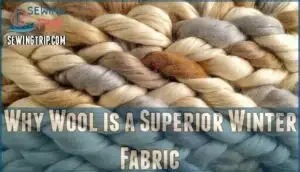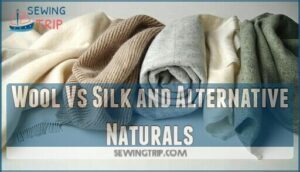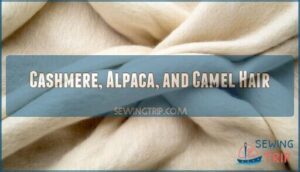This site is supported by our readers. We may earn a commission, at no cost to you, if you purchase through links.

The fiber’s natural crimp creates millions of tiny air pockets that act like personal insulation bubbles. Unlike cotton or synthetic materials, wool maintains its warming power even when damp, making it reliable in harsh conditions.
Different wool types offer varying warmth levels, with cashmere providing eight times more insulation than regular wool.
Table Of Contents
Key Takeaways
- You’ll stay warm in wool down to -20°F because it generates actual heat through a chemical reaction when moisture from your skin contacts the fibers.
- Wool maintains its insulating power even when wet, unlike cotton or synthetic materials that lose effectiveness and can steal body heat from you.
- Different wool types offer varying warmth levels – cashmere provides eight times more insulation than regular wool, while merino works best for base layers.
- You’ll get maximum warmth by layering merino wool base layers, adding wool mid-layers, and choosing quality pieces with dense weaves that trap more air.
How Warm is Wool for Winter?
When you’re facing winter’s harsh bite, wool stands as nature’s most reliable thermal shield. This remarkable fiber doesn’t just keep you warm—it actively regulates your body temperature through a complex system of moisture management and heat retention that synthetic materials simply can’t match.
Wool’s Insulating Properties Explained
When wool fibers absorb moisture from your body, they create heat of sorption—a fascinating chemical reaction that generates warmth. Wool’s unique fiber structure forms millions of tiny air pockets that trap heated air next to your skin. This natural thermal resistance mechanism makes wool an exceptional temperature regulator, providing superior heat retention compared to synthetic alternatives.
Wool doesn’t just keep you warm—it actually generates heat when it gets wet
Factors Affecting Wool’s Warmth
Several key factors determine how effectively wool keeps you warm during winter activities. Understanding these variables helps you choose the right wool garments for your specific needs.
Key factors that impact wool’s warmth:
- Wool thickness and weave density – Thicker fabrics with tighter weaves trap more air pockets, boosting insulating properties substantially.
- Fiber crimp and wool fiber properties – Fine merino wool’s natural crimp creates countless tiny air spaces that boost heat generation through improved air retention.
- Moisture content and heat of sorption – Wool’s ability to absorb up to 30% of its weight while releasing heat energy maintains wool performance even in damp conditions.
Wool’s structure creates natural insulation properties due to air pockets.
Wool’s Performance in Extreme Cold
Adventurers know that when temperatures plummet below zero, your gear becomes your lifeline. Wool’s unique structure creates heat through a chemical process when moisture contacts the fibers, making it ideal for extreme conditions where synthetic materials fail.
| Temperature Range | Wool Performance | Competing Materials |
|---|---|---|
| 0°F to -20°F | Excellent heat generation, maintains loft | Down loses insulation when wet |
| -20°F to -40°F | Continues insulating, prevents frostbite | Synthetic fills become stiff |
| High altitude/wind | Wool clothing blocks wind, retains warmth | Cotton steals body heat |
| Wet conditions | Wools wet performance generates heat | Polyester winter outerwear fails |
| Polar exploration | Used by professionals for safety | Other materials risk hypothermia |
This heat generation through moisture absorption makes wool the go-to choice for polar exploration apparel and frostbite prevention in cold weather conditions.
Why Wool is a Superior Winter Fabric
When you’re choosing between natural and synthetic fabrics for winter, wool consistently outperforms man-made alternatives that can actually steal heat from your body.
You’ll discover that wool’s unique fiber structure not only traps warm air but also regulates moisture and temperature naturally, while synthetic materials often leave you clammy and cold.
Natural Vs Synthetic Fibers
You’ll face a clear choice when picking winter gear: natural fibers versus synthetic fibers. Understanding their manufacturing processes helps you make informed decisions about insulating properties and environmental impact.
Here’s what sets them apart:
- Fiber biodegradability – Wool decomposes naturally while synthetics create microplastic pollution
- Petrochemical dependence – Synthetics rely on oil-based materials, wool doesn’t
- Ethical sourcing – Natural fibers support sustainable farming practices
- Performance – Wool maintains warmth when wet, synthetics dry faster
Polyester, conversely, can trap moisture and heat, leading to discomfort. Natural fibers win for eco-conscious adventurers.
Health and Skin Benefits
Your skin’s barrier function gets a boost from hypoallergenic wool, which naturally resists bacteria and odors. Unlike synthetic materials that can irritate sensitive skin, wool’s breathable fibers promote skin health by preventing overheating.
Considering that breathability matters most, wool stands out as a superior choice. Children’s health particularly benefits from wool’s healing properties, as natural wellness comes from fabrics that work with your body rather than against it.
Wool’s Moisture-Wicking and Breathability
Unlike synthetic materials that trap sweat against your skin, wool fiber’s unique structure creates exceptional moisture wicking through a process called heat of sorption. When water vapor from your body contacts the wool fiber, it releases energy that actually warms you up.
This temperature regulation system keeps you comfortable by moving moisture away while maintaining breathability. The result? Superior sweat management, natural odor resistance, and comfort levels that synthetic fabrics simply can’t match.
How Wool Compares to Other Winter Fabrics
When you’re shopping for winter gear, you’ll quickly discover that not all fabrics handle cold the same way. Cotton soaks up moisture like a sponge and leaves you shivering, while synthetic materials often trap odors and can’t match wool’s natural temperature regulation.
Wool Vs Cotton for Cold Weather
Cotton becomes a heat thief in cold weather. When you sweat, cotton garments soak up moisture and stay wet for hours, pulling precious warmth from your body.
Wool’s superior moisture retention means it can absorb 30% of its weight without feeling damp. This dramatic difference in drying time makes wool the clear winner for base layer comfort and insulation value in any layering strategy.
Wool is also known for its excellent insulation properties.
Wool Vs Polyester and Synthetic Insulators
When choosing between wool and synthetic fibers like polyester for keeping warm, wool wins the insulation comparison hands down. Polyester warmth drops significantly when wet, while wool maintains heat retention even soaked.
Synthetic fill compresses over time, losing effectiveness. Plus, synthetic breathability can’t match wool’s natural temperature regulation.
Natural fabric beats synthetic alternatives every time, without the microplastic pollution concerns that come with washing polyester garments.
Wool Vs Silk and Alternative Naturals
Silk insulation offers unique benefits as a natural fabric alternative to wool. You’ll find silk incredibly lightweight yet surprisingly warm, making it perfect for base layers. Cashmere provides luxury softness but costs more than wool. Plant-based alternatives like bamboo fiber show promise, though they lack wool’s proven durability.
Fabric blends combining wool with silk create versatile options for keeping warm. Ensuring ethical sourcing remains important when choosing any natural material. Fabric blends combining wool with silk create versatile options for keeping warm.
Types of Wool and Their Warmth Levels
When you’re shopping for wool winter gear, you’ll discover that different types of wool offer varying levels of warmth and comfort. From ultra-fine merino that works perfectly against your skin to luxurious cashmere that’s lighter than you’d expect, each wool type brings its own superpower to your cold-weather wardrobe.
Merino Wool Base Layers
Merino wool base layers offer unmatched comfort for winter activities. You’ll appreciate how merino softness eliminates the scratchy feeling of traditional wool.
These wool base layers provide superior odor resistance, keeping you fresh during high activity levels. The natural base layer fit moves with your body while creating an effective layering system.
Merino wool underlayers regulate temperature through moisture-wicking properties, making them essential foundation pieces for cold-weather adventures. Many seek a quality merino option for optimal performance.
Cashmere, Alpaca, and Camel Hair
Cashmere warmth surpasses regular wool by eight times, while alpaca benefits include hollow-core insulation that handles cold weather down to -20°C. Camelhair durability comes from its dual-layered structure, providing natural wind resistance. These luxury blends often combine with merino for easier care. A popular option is cashmere alpaca blends.
When selecting woolen fiber for body temperature regulation during winter weather, fiber sourcing matters. Choose traceable, responsibly harvested options that deliver premium warmth without compromising sustainability.
Wool Coats, Sweaters, and Accessories
Winter clothing transforms into your personal heating system when you choose the right pieces. A well-constructed wool coat with tight weaves and proper lining beats thin alternatives every time. Sweater styles, from chunky knits to fine-gauge merino, create versatile winter layers. Wool accessories like scarves and gloves seal warmth gaps that steal precious heat.
Blended fabrics combine wool’s natural warmth with durability, while ethical sourcing ensures your woolen winter jacket supports responsible farming practices. Consider warm winter coats for superior protection.
Choosing and Caring for Wool Winter Clothing
You’ll get the most warmth from your wool investment when you know how to choose quality pieces and keep them in top condition. Smart layering strategies and proper care will extend your wool’s lifespan while maximizing its insulating power through countless winter adventures.
Layering Tips for Maximum Warmth
Perfect layering starts with merino wool base layers against your skin, then add mid-layer insulation like wool sweaters. Your outer layers should block wind and moisture. Remember the layering order: base layer fabrics first, then insulation, finally outerwear protection.
Adjust layers based on activity level to prevent overheating and heat loss in cold weather.
Selecting Quality Wool Products
Quality matters when you’re investing in wool. Look for dense weaves that trap more air—they’ll keep you warmer. Pure wool fabric with tight construction beats loose knits every time.
Check the blend composition; pure wool offers better performance than mixed fabrics. Examine fiber quality by feeling the texture. Product certification from ethical sourcing ensures your woolen winter jacket meets standards.
Consider breathability and warmth when selecting wool.
Sustainable and Eco-Friendly Wool Choices
Looking beyond quality alone, you’ll want wool that aligns with your values. Ethical Wool from Regenerative Agriculture supports soil health while reducing your carbon footprint.
Choose Biodegradable Wool with Low-Impact Dyes over synthetic alternatives. Wool Recycling programs extend fiber life, making Pure Wool Fabric a smart Sustainable Fashion Choice that benefits both you and the planet.
Wool Care and Maintenance Tips
Taking care of wool clothing properly extends its lifespan and maintains warmth. Here’s your essential care roadmap:
- Washing Wool: Use cold water and wool-specific detergent for machine washing delicate cycles
- Drying Methods: Lay flat on towels, avoiding direct heat or hanging
- Stain Removal: Blot immediately, never rub wool fibers aggressively
- Storage Solutions: Clean before storing, use cedar blocks for moths
- Repairing Knits: Address small holes quickly with matching yarn
Frequently Asked Questions (FAQs)
Is wool suitable for people with sensitive skin or allergies?
Yes, you’ll find wool works well for sensitive skin, especially merino wool. It’s naturally hypoallergenic, soft, and non-itchy. The fine fibers won’t irritate your skin like traditional wool can.
Does the thickness of the wool affect its warmth?
Thicker wool definitely increases warmth by creating more insulating air pockets. You’ll notice heavier-weight wool garments trap body heat better than lightweight versions, making thickness a key factor in staying cozy outdoors.
How does the quality of wool affect its performance in winter weather?
Higher-quality wool offers superior warmth through better fiber construction and processing. Premium merino wool features finer fibers that trap more air, creating better insulation. You’ll stay warmer longer with quality wool that maintains its loft and moisture-wicking properties.
Does wool cause allergic reactions or itching?
Most people don’t experience allergic reactions to high-quality merino wool since it’s naturally hypoallergenic. However, coarser wool types can cause itching or irritation for sensitive skin types.
How much does quality wool clothing cost?
Like shopping for a diamond, quality wool clothing ranges from budget gems to precious investments. You’ll find basic merino pieces starting around $45 for underwear, with mid-range items reaching $100-
Premium quality pieces cost more but last years.
Can wool shrink in the washing machine?
Yes, wool can shrink in the washing machine if you use hot water or high heat. Always wash wool in cold water on a gentle cycle and air dry it to prevent shrinking.
Is wool effective in wet snowy conditions?
Snow swirls around you, but wool’s got your back! Its fibers absorb moisture while trapping warm air pockets next to your skin.
Even when wet, wool maintains insulation, keeping you cozy.
What wool weight works best for hiking?
For hiking, you’ll want lightweight merino wool weighing 150-200 GSM. This weight provides excellent moisture-wicking without bulk, keeping you comfortable during active movement while maintaining warmth when you stop to rest.
Conclusion
While synthetic fabrics promise high-tech warmth, wool delivers time-tested reliability that’s kept humans comfortable for millennia. Understanding how warm wool is for winter transforms your cold-weather clothing choices completely.
From merino base layers to luxurious cashmere, wool’s unique ability to generate heat through moisture contact sets it apart from every other fabric. Whether you’re facing -20°F temperatures or mild winter days, choosing quality wool means investing in nature’s most sophisticated insulation system that actually works with your body’s natural processes.














